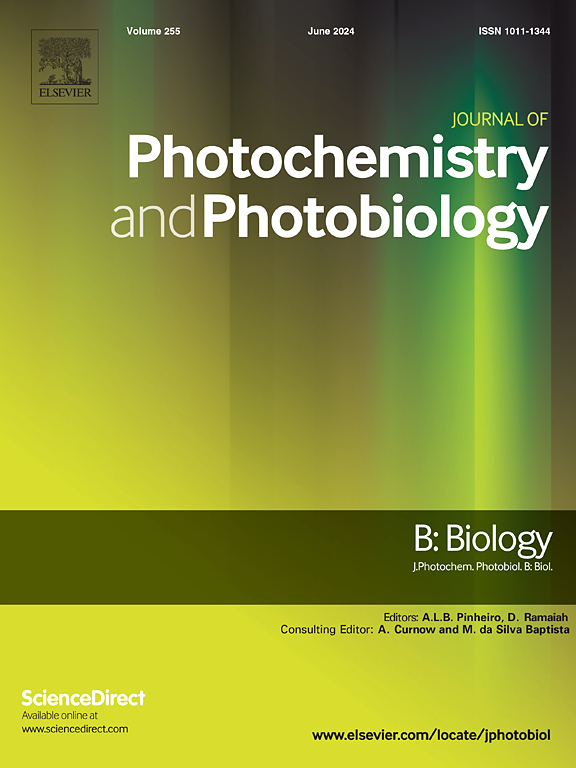Photobiomodulation mitigates DHT-induced apoptosis in dermal papilla cells via mitochondrial rescue and Wnt/TGF-β/BMP signaling modulation
IF 3.7
2区 生物学
Q2 BIOCHEMISTRY & MOLECULAR BIOLOGY
Journal of photochemistry and photobiology. B, Biology
Pub Date : 2025-07-02
DOI:10.1016/j.jphotobiol.2025.113210
引用次数: 0
Abstract
Current therapeutic interventions for androgenetic alopecia (AGA) are hindered by limited efficacy and adverse side effects. Photobiomodulation (PBM) has emerged as a promising non-invasive alternative, demonstrating preliminary potential for hair follicle stimulation. However, its precise therapeutic mechanisms and optimal treatment parameters require systematic investigation. In the present study, we established an in vitro AGA model using dihydrotestosterone (DHT)-treated human dermal papilla cells (DPCs, 0–100 μM) to evaluate PBM efficacy across continuous wave (CW) and pulsed wave (PW) modes, enabling mechanistic and therapeutic assessment. Key findings revealed that the impact of PBM was highly sensitive to DHT concentration. At lower concentrations of DHT (0–50 μM), PBM therapy successfully improved mitochondrial function, reduced apoptosis, increased alkaline phosphatase activity, stimulated lactate dehydrogenase release, and boosted cell migration. These beneficial effects were particularly notable under 8 J/cm2 and 8 mW/cm2 (CW mode), as well as 8 J/cm2, 10 mW/cm2 (peak irradiance), 500 Hz, and 80 % duty cycle under PW mode. However, these protective effects were substantially attenuated at higher DHT concentrations (100 μM). Mechanistically, PW PBM exerted dual anti-apoptotic and anti-androgenic effects through multi-pathway modulation: It activated the Wnt/β-catenin pathway while concurrently suppressing BMP and TGF-β signaling cascades. This investigation elucidates the molecular mechanisms by which PBM inhibits DHT-induced apoptosis in DPCs. Furthermore, it demonstrates that the therapeutic efficacy of PBM is significantly mitigated under hyperandrogenic conditions. Overall, our findings provide critical insights for optimizing light-based therapeutic strategies and advancing clinical translation of PBM for AGA management.

光生物调节通过线粒体拯救和Wnt/TGF-β/BMP信号调节减轻dht诱导的真皮乳头细胞凋亡
目前雄激素性脱发(AGA)的治疗干预措施受到有限的疗效和不良副作用的阻碍。光生物调节(PBM)已成为一种有前途的非侵入性替代方法,初步显示出刺激毛囊的潜力。然而,其确切的治疗机制和最佳治疗参数需要系统的研究。在本研究中,我们利用二氢睾酮(DHT)处理的人真皮乳头细胞(DPCs, 0-100 μM)建立了体外AGA模型,通过连续波(CW)和脉冲波(PW)模式来评估PBM的疗效,从而进行机制和治疗性评估。关键发现显示PBM的影响对DHT浓度高度敏感。在较低浓度DHT (0-50 μM)下,PBM治疗成功改善线粒体功能,减少细胞凋亡,增加碱性磷酸酶活性,刺激乳酸脱氢酶释放,促进细胞迁移。这些有益效果在8 J/cm2和8 mW/cm2(连续模式)以及8 J/cm2、10 mW/cm2(峰值辐照度)、500 Hz和80% PW模式下尤为显著。然而,当DHT浓度升高(100 μM)时,这些保护作用明显减弱。机制上,PW PBM通过多通路调节发挥抗凋亡和抗雄激素的双重作用:激活Wnt/β-catenin通路,同时抑制BMP和TGF-β信号级联。本研究阐明了PBM抑制dht诱导的DPCs细胞凋亡的分子机制。此外,研究表明,在高雄激素条件下,PBM的治疗效果显著降低。总的来说,我们的研究结果为优化基于光的治疗策略和推进PBM在AGA管理中的临床转化提供了重要的见解。
本文章由计算机程序翻译,如有差异,请以英文原文为准。
求助全文
约1分钟内获得全文
求助全文
来源期刊
CiteScore
12.10
自引率
1.90%
发文量
161
审稿时长
37 days
期刊介绍:
The Journal of Photochemistry and Photobiology B: Biology provides a forum for the publication of papers relating to the various aspects of photobiology, as well as a means for communication in this multidisciplinary field.
The scope includes:
- Bioluminescence
- Chronobiology
- DNA repair
- Environmental photobiology
- Nanotechnology in photobiology
- Photocarcinogenesis
- Photochemistry of biomolecules
- Photodynamic therapy
- Photomedicine
- Photomorphogenesis
- Photomovement
- Photoreception
- Photosensitization
- Photosynthesis
- Phototechnology
- Spectroscopy of biological systems
- UV and visible radiation effects and vision.

 求助内容:
求助内容: 应助结果提醒方式:
应助结果提醒方式:


